How to Add an Account on an Hp Laptop
Z7_3054ICK0KGTE30AQO5O3KA30N0
hp-concentra-wrapper-portlet
![]() Actions
Actions
HP PCs - Managing User Accounts and Logins (Windows 10)
This document is for HP computers with Windows 10.
Passwords and separate accounts help keep the information on the computer private and secure. The information in this document describes the different account types in Windows 10, explains how to change account types, and how to save and change passwords and other sign-in options.
This document also explains how use a Microsoft account to sync your personal settings and software applications to other Windows 10 devices, connect apps to accounts, and link contacts.
Recommended: Use a Microsoft-connected account to log in to Windows
There are two ways to sign in to Windows - with a Microsoft account and with a local account.
-
Microsoft account
-
Log into Windows using an email address and password.
-
Reset your password or manage your account using a different device at any time.
-
Sync your settings and files across desktops, laptops, and phones.
-
Install Desktop apps and apps from the Windows store.
-
-
Local account
-
Log into Windows using a user name and password.
-
Reset password or manage account.
-
Access the system resources and customize the computer with your own settings and preferences.
-
Install Desktop apps, but not apps from the Windows store.
-
HP recommends using a 'connected account' with Microsoft to sign in to Windows. With a Microsoft connected account, you sign in to Windows using your email address. The password can be reset using a different device at any time. You do not need a Microsoft or Hotmail email address to set up a connected account. Any email address works.
For steps to create a Microsoft connected account in Windows 10, see Creating a new account in this document.
caution:If you are using a local-user account, HP cannot recover or reset your password if it is lost or forgotten.
If you prefer to use a local-user account, HP strongly recommends creating a password reset disk to enable you to reset your password in case it is forgotten. If you do not have a password reset disk and you forget your password, you might be directed to perform a full recovery to original factory conditions. In this case, you will lose any data that was not backed up to an external location. For more information about creating a password reset disk, see Creating a Password Reset Disk (Windows).
Types of user accounts in Windows 10
The Welcome screen shows the accounts on the computer. Click an account on the Welcome screen to sign in.
There are two types of user accounts in Windows 10 with each account type having different levels of access. The following list shows the account types and levels of control for each.
-
Standard account
-
Can be a local user account or Microsoft-connected account.
-
Change, edit, or delete the password.
-
Change the account picture.
-
Cannot install or open new programs.
-
-
Administrator account (highest level of control of the operating system)
-
Can be a local user account or Microsoft-connected account.
-
Create accounts.
-
Set and change privileges.
-
Change passwords for user accounts.
-
Install and open certain programs.
-
Creating a new account
Create a new account using the Accounts settings.

-
Sign in to an administrator account, and then make sure the computer is connected to the Internet.
-
In Windows, search for and open Manage your account. You can also click Start
 , select Settings
, select Settings  , and then select Accounts.
, and then select Accounts.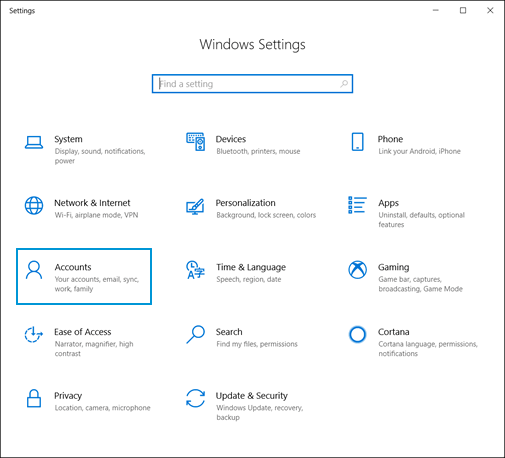
-
On the Accounts window, select Family & other users, and then click Add someone else to this PC.
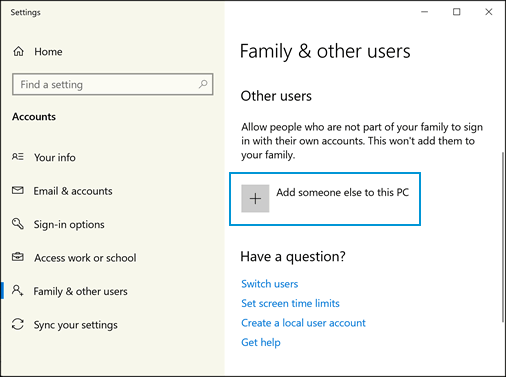
-
On the How will this person sign in? screen, choose an option depending on whether you have the sign-in information for the new account.
-
If you have the sign-in information: Type the email address or phone number of the person for whom the new account is being set up, and then click Next. Click Finish. The new account is created.
-
If you do not have the sign-in information: Click I don't have this person's sign-in information, and then continue with these steps.
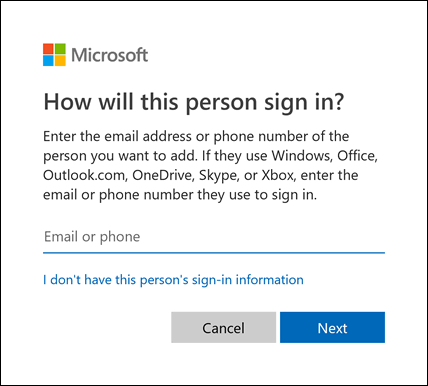
-
-
Type an existing email address or create a new one, type a password, select your country or region, select your birth date information, and then click Next to create a new Microsoft account (MSA).
note:
If you do not wish to create a new MSA, select Add a user without a Microsoft account, and then create a user name and password for a new local account.
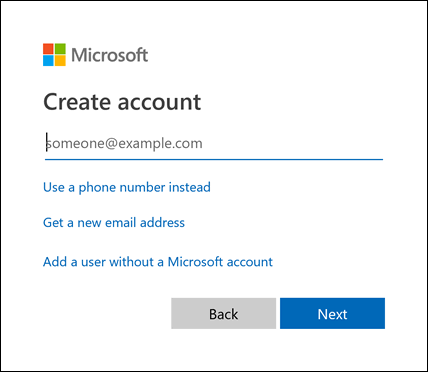
-
Type the user name of the person for whom the new account is being set up. Type a password in the Enter password field, then type it again in the Re-enter password field. Next, choose a security question from the Security question 1 field and type your answer in the Your answer field. Do this again for the two remaining security questions. Click Next. The new account is created.
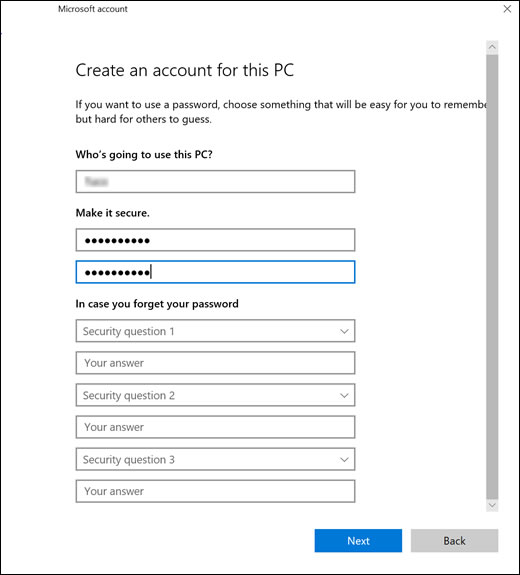
Using a Microsoft account
When using a Microsoft account in Windows 10, you can do a variety of things. Information about the following topics is in the sections below.
-
Access files from other computers and devices using OneDrive.
-
Install Windows store apps you already own on other devices.
-
Link all your contacts using the People app.
Accessing files from other devices using OneDrive
Files stored on OneDrive can be viewed, uploaded, and shared from other computers and devices. For more information, see OneDrive on your PC (in English) from Microsoft Support.
Installing your apps on other devices
Apps obtained from the Windows Store can be installed on up to five Windows 10 computers. Go to the Windows Store to see a list of apps you own and to install the apps on other computers.
-
On the Windows 10 device you want to install an app, sign in to your Microsoft account.
-
On the taskbar, click the Store icon
 .
. -
In the Windows Store, click the More icon
 , and then select My Library.
, and then select My Library.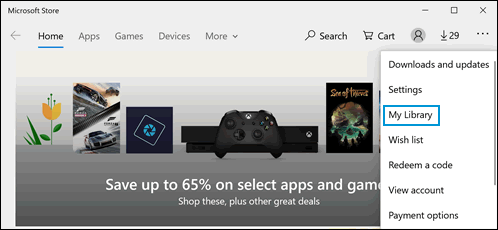
-
Find the app you want, and then select the Install.
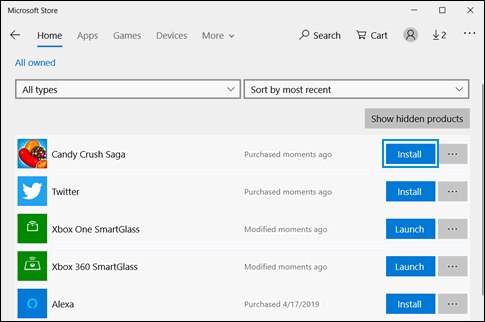
Linking accounts and contacts with the People app
Link Twitter, Outlook, LinkedIn, and other accounts to the People app, where you can add contacts from lists and address books. View the online status of your contacts, as well as ways to interact with them.
Adding your accounts to the People app
Add your email, social networking, and other accounts to the People app. The instructions also work for linking accounts to other apps.
-
In Windows, search for and open People.
note:
When you add your email account, Windows 10 automatically adds your email contacts to the People app.
-
Click Get started.

-
Click Import contacts.

-
Select the type of account you want to add. Choose from Outlook.com, Exchange, Google, Yahoo!, or iCloud.
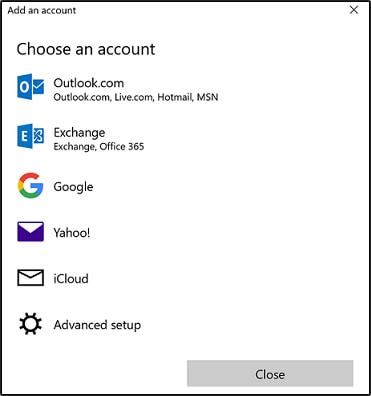
-
Click the account you want to add, and then follow the on-screen instructions.
-
When you are finished adding accounts, click Ready to go.
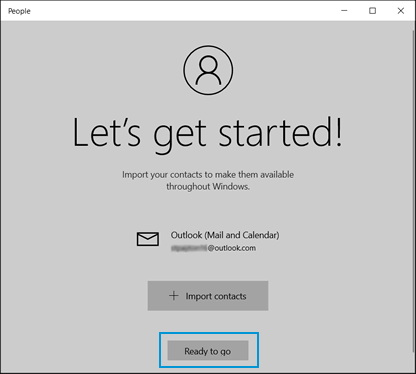
Adding multiple profiles to one contact
When you have multiple modes for contacting people, such as email and Twitter, you can add all the profiles for each contact in the People app. All ways to communicate with a contact display in the People app profile.
-
In Windows, search for and open People.
-
Select the name of a contact to open the profile.
-
Scroll down the profile page of the contact, and then select See more.
-
Add or remove a contact from the selected contact's profile:
-
Add a contact to a profile: Select Find a contact to combine, and then select the contact you want to add.
-
Remove a contact from a profile: Click Separate under the contact.
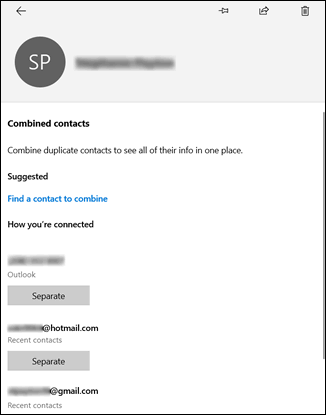
-
-
To communicate with a contact, open the contact's profile, and then click an option from the list, such as Mail or Skype.
Windows opens the app for the selected option. For example, if you select Mail, the Mail app opens and creates a draft email addressed to the contact.
-
To pin a contact to the taskbar, open the contact's profile, click the Pin icon
 , and then select Pin to Taskbar.
, and then select Pin to Taskbar.Contacts display as icons on the taskbar.
note:
If the People
 icon displays on the taskbar, click the icon, click Find and pin contacts, and then select the contact you want to pin to the taskbar.
icon displays on the taskbar, click the icon, click Find and pin contacts, and then select the contact you want to pin to the taskbar.
Changing your Microsoft account password
If you know your current Microsoft account password and want to change it, use the Accounts settings to change your password.
-
Sign in to your Microsoft account, and then make sure the computer is connected to the Internet.
-
In Windows, search for and open Manage your account. You can also click Start
 , select Settings
, select Settings  , and then select Accounts.
, and then select Accounts.
-
On the Accounts window, select Sign-in options, and then select Password.

-
Click Change. If a window displays prompting you to verify your identity, type the requested credentials.
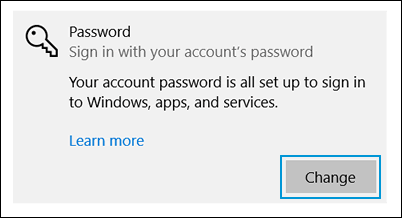
-
Type your current password and a new password in the appropriate fields, and then click Next.
-
Current password field
-
New password field

-
-
Click Finish.
You can now sign in using the new password.
Setting up local account security questions
Set up security questions to avoid losing access to your local account in case you forget your password.
-
Sign in to your local account, and then make sure the computer is connected to the Internet.
-
In Windows, search for and open Manage your account. You can also click Start
 , select Settings
, select Settings  , and then select Accounts.
, and then select Accounts.
-
On the Accounts window, select Sign-in options, and then select Password.

-
In the Password area, click Update your security questions. If a window displays asking you to verify your identity, type the requested credentials.
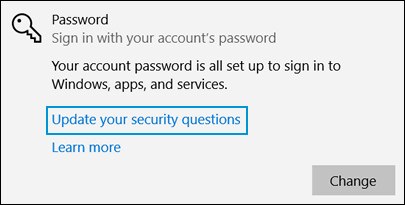
-
Choose a security question from the Security question 1 field and type your answer in the Your answer field. Do this again for the two remaining security questions.
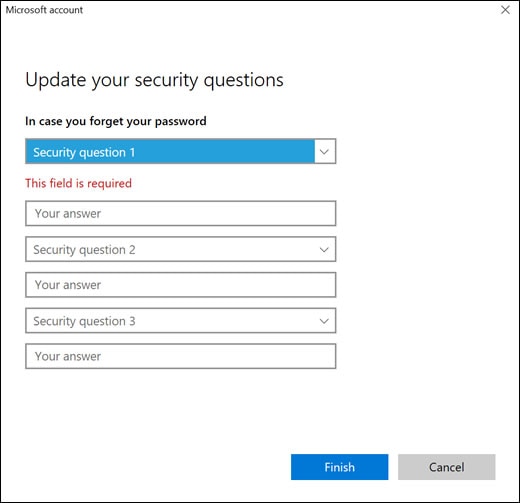
-
Click Finish.
Your security questions are now updated.
Creating a password reset disk before you forget your local account password
If you prefer to use a local-user account, HP strongly recommends creating a password reset disk to enable you to reset your password in case it is forgotten. Create the password reset disk before you forget your password, while you have access to Windows. If you do not have a password reset disk and you forget your password, you might be directed to perform a full recovery to original factory conditions. In this case, you can lose any data that was not backed up to an external location.

Resetting a lost password
When you forget your password, use the following instructions to create (reset) a password in Windows 10.
Reset your Microsoft account password
If you have forgotten the password that you use to sign in to Windows 10, you can reset the password using any computer or device that has Internet access. Sign in to the other device and use the following instructions:
-
Select I forgot my password, and then click Next.
-
Follow the on-screen instructions to reset your password.
When the password is reset, you can use your Microsoft account with the new password to sign in to your Windows 10 device. Make sure Windows 10 is connected to the Internet before you attempt to sign in.
Reset your local user account password using security questions
You can reset your forgotten password by answering the security questions you set up when you created your local account.
To use this option, you must have previously set up security questions for your local account.
note:If you continue to use a local account, you might not be able to reset your password if it is lost or forgotten. HP recommends using a Microsoft account to sign in to Windows. With a Microsoft account, your password can be reset using any Internet-connected device at any time.
-
Turn on the computer and attempt to type the sign-in password at the Windows sign-in screen.
-
If the password was entered incorrectly, a message displays indicating the password is incorrect. Click OK.

-
Click Reset password.
-
Your three security questions display. Type your secret answers to each question. After the last question, press Enter.
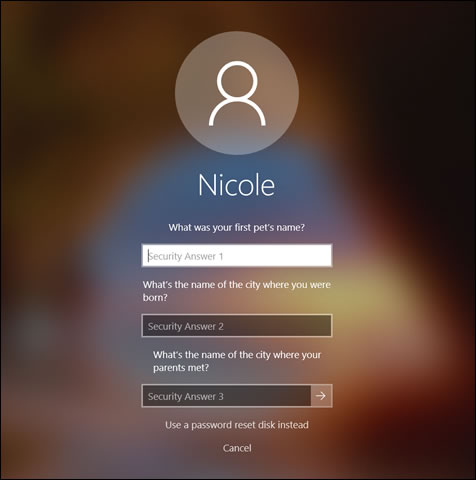
-
In the spaces provided, type a new password, and then type it again to confirm. When done, press Enter.
You are now signed in and your local password is reset.

Reset your local user account password using a password reset disk
If you have forgotten the password of your user account and you have a password reset disk, you can reset the password using the password reset disk. Find the disk or USB flash drive and use the following steps to reset the local account password.
note:This method applies to local accounts only. A password reset disk does not reset a Microsoft account password. If you do not have a password reset disk, use one of the other sections in this document to access Windows.
-
Turn on the computer and attempt to type the sign-in password at the Windows sign-in screen.
-
If the password was entered incorrectly, a message displays indicating the password is incorrect. Click OK.

-
Insert your password reset disk, and then click Reset password.
The Password Reset Wizard displays.
-
Click Next.
-
Select the password key location from the drop-down menu, and then click Next.
-
In the spaces provided, type a new password, type it again to confirm, and then create a password hint to help you remember the password in the future.
-
Click Next.
-
Click Finish.
-
Use the new password to sign in to Windows. You do not need to create a new password reset disk for the new password.
Change the local user account password from another user account
If you have forgotten the password of your user account, you can change the local user account password using another administrator account on the system. Use the following steps if there is another account on the system that has administrator rights. You might need help from the owner of the account.
-
Sign in using an account that has administrator rights.
-
In Windows, search for and open Control Panel.
-
In the Control Panel search field, type User Accounts, and then click User Accounts from the list.
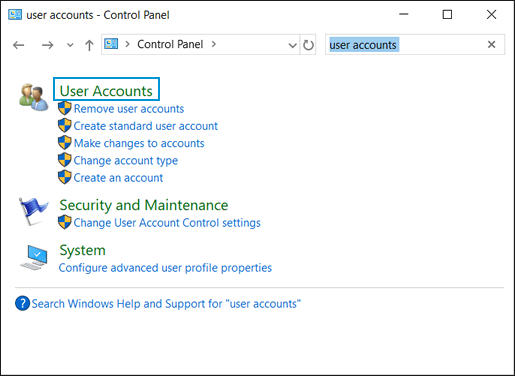
-
Click Manage another account.
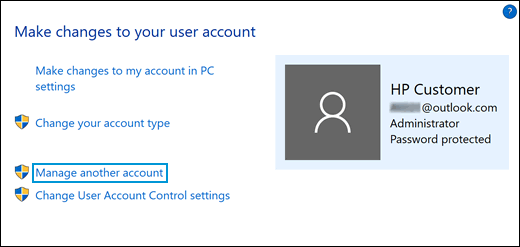
-
Select the local account with the forgotten password.
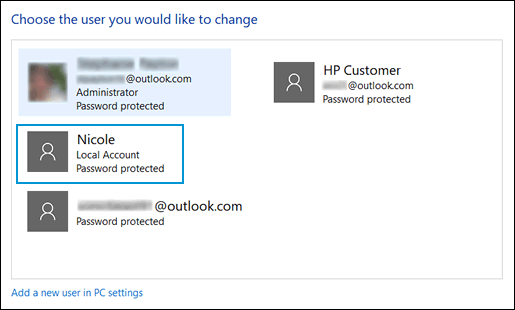
-
Click Change the password.

-
Type the new password, and then type the password again to confirm.
-
Type a password hint to help you remember the password in the future.
-
Click Change password.

You can now sign in to the local account using the new password.
Access your account when no other option is available
If you do not have a Microsoft connected account, there are no other accounts in Windows with administrator rights, and you do not have a password reset disk, try these other options:
-
You can perform a Windows reset to completely erase all files, including local account password information, and reset the computer back to its original settings. For more information, see Microsoft Push-Button Reset (Windows 10).
-
Call local computer repair and service stores. Local stores might offer password recovery services for a fee.
Setting up an account PIN
A Windows 10 account PIN replaces reusable passwords with the combination of a specific device and the PIN.

-
In Windows, search for and open Manage your account. You can also click Start
 , select Settings
, select Settings  , and then select Accounts.
, and then select Accounts.
-
On the Accounts window, select Sign-in options, and then select Windows Hello PIN.
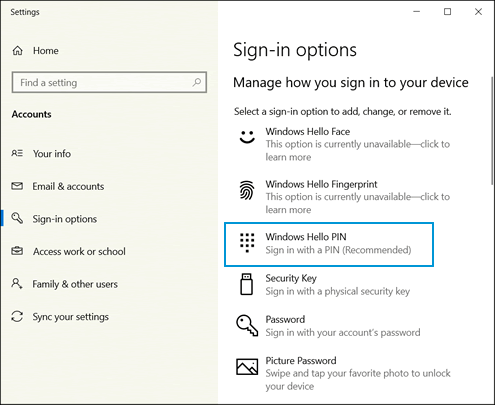
-
In the Windows Hello PIN area, click Add, and then click Next. If a window displays prompting you to verify your identity, type the requested credentials.

-
On the Windows Security window, type a PIN, type the PIN again to confirm, and then click OK.
-
PIN field
-
Confirm the PIN field
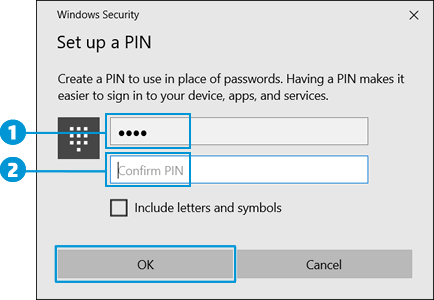
-
Your account PIN is set up, and you can use it to sign in.
Setting up Windows Hello
Windows Hello lets you unlock your Windows 10 devices by using your fingerprint, facial recognition, PIN, or picture password. This technology is much safer than traditional passwords since you and your device provide the authentication to Windows, your apps, and your data.
If your computer has the necessary hardware (fingerprint reader or IR web camera), Windows Hello is installed automatically during the Windows installation.
Setting administrator privileges for an account
If a standard account requires administrator privileges, you can log into any account that already has administrator privileges and change the account settings.
-
Sign in using an administrator account.
-
In Windows, search for and open Manage your account. You can also click Start
 , select Settings
, select Settings  , and then select Accounts.
, and then select Accounts.
-
On the Accounts window, select Family & other users, and then select the user account you want to change in the Other users area.

-
Select Change account type.
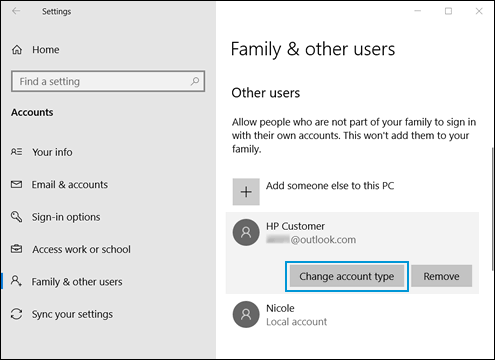
-
Click the Account type drop-down menu.
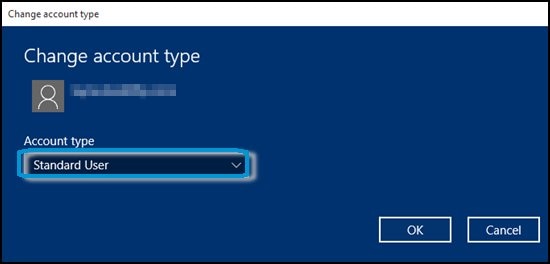
-
Select Administrator, and then click OK.
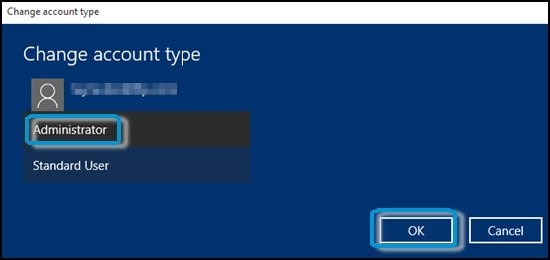
Removing a password from a local account
If you do not want the computer to require a password to sign in to your local account, remove the password using the Accounts settings.
note:If you use a Microsoft account, you cannot remove the password.
-
Sign in to your local user account.
-
In Windows, search for and open Manage your account. You can also click Start
 , select Settings
, select Settings  , and then select Accounts.
, and then select Accounts.
-
On the Accounts window, select Sign-in options, and then select Password.

-
In the Password area, click Change.
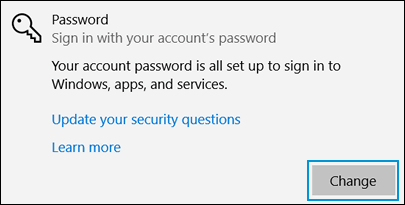
-
Type your current password in the Current password field, and then click Next.
-
On the Change your password window, leave all the fields empty, and then click Next.
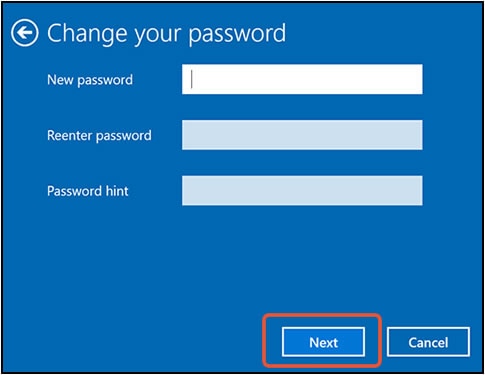
-
Click Finish.
You can now sign in to the local user account without using a password.
Adding a password for a local account
If your local account does not use a password, but you want the computer to require a password to sign in to your account, use the Accounts settings to set a password.
-
Sign in to your local user account.
-
In Windows, search for and open Manage your account. You can also click Start
 , select Settings
, select Settings  , and then select Accounts.
, and then select Accounts.
-
On the Accounts window, select Sign-in options, and then select Password.

-
In the Password area, click Add.

-
Type the new password, and then type the password again to confirm.
-
Type a password hint to help you remember the password in the future.
-
Click Next.
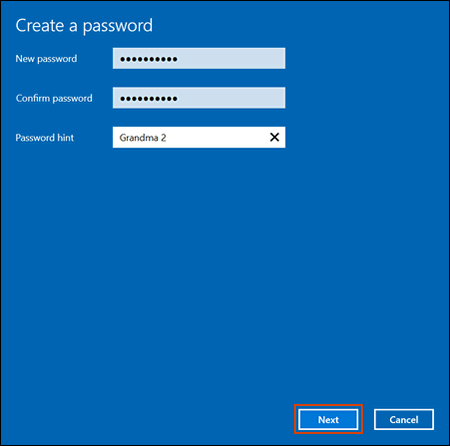
-
Click Finish.
The computer requires the new password next time you sign in to your local account.
Disabling the password requirement
If you do not want the computer to require a password to sign in for all user accounts, you can disable the password requirement.
note:If your computer is connected to a network domain, you might not be able to disable the password requirement.
-
Sign in to a Microsoft account with administrator privileges.
-
In Windows, search for and open netplwiz.
-
Deselect the Users must enter a user name and password to use this computer box, and then click OK.

-
In the appropriate fields, type your password, type your password again to confirm, and then click OK.
The computer is set to automatically sign in to your account.
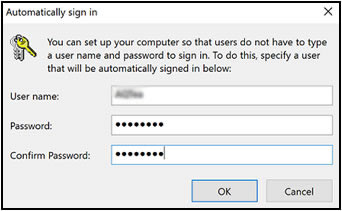
-
Restart your computer.
The computer restarts, and the desktop displays without requiring a password.
How to Add an Account on an Hp Laptop
Source: https://support.hp.com/id-en/document/c04648962
0 Response to "How to Add an Account on an Hp Laptop"
Post a Comment